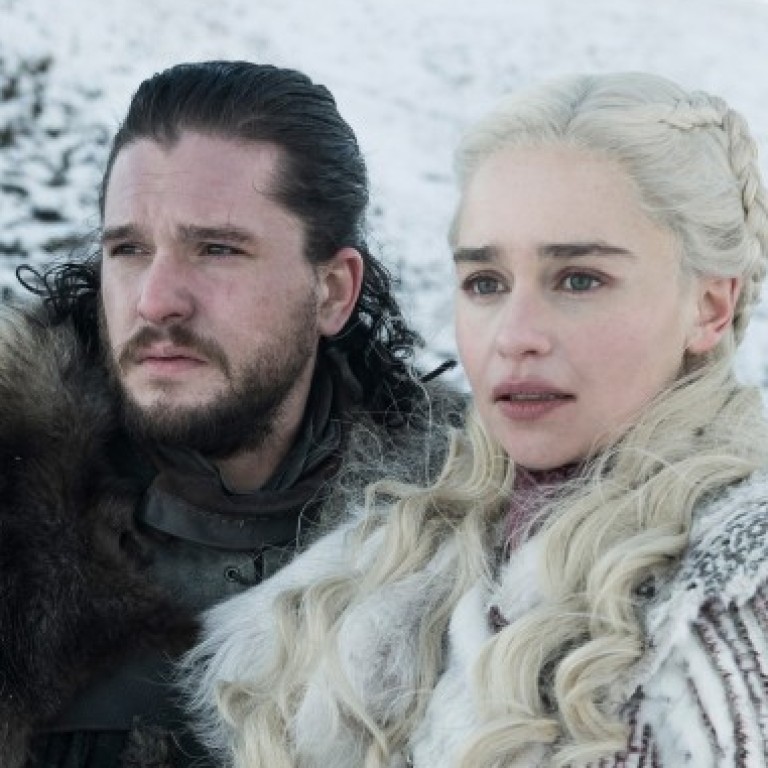
How Netflix’s rise and Game of Thrones finale mark the end of TV as we know it
- Netflix ushered in era of binge watching by releasing the entire TV series on the same day
- The weekly episodes of Game of Thrones, and the office conversations around them and other series, could soon be a thing of the past
This is it. After eight seasons of sword fights, zombies, dragon fire, political skulduggery and uncomfortably close family relations, HBO’s Game of Thrones has finally come to the end of its run.
That’s big news for fans – the network says a whopping 18.4 million people watched the penultimate episode of the show – but this moment marks something bigger than just the end of an epic fantasy story; it’s the end of TV as we know it.
For decades, broadcast television has been the connective tissue of offices; whatever personal, political or professional differences we might have, the triumphs and tragedies beamed nightly into our living rooms have provided much-needed common ground.
Not just businesses, either – the show counts among its fans Barack Obama, Beyoncé and Madonna.
That’s partly thanks to the show’s varied genetic make-up; a heady mix of lurid sex and violence, high-minded political intrigue, down-to-earth characterisation and bold fantasy tropes.
It’s a show that will have characters bargaining loans with a bank one season and firing ballistas at dragons the next – there is something for everyone, so long as they have strong stomachs.

But the real key to Thrones’ success is, and has always been, that it unfolds piece by piece, chapter by chapter, just like the novels it’s based upon.
With at least a week between episodes – and a gap of one year and eight months between the end of season seven and the start of this final season – there has been plenty of time for fans to think, speculate and argue about what they’ve seen, where the characters are, and where they’re likely to end up next.
This has persisted for the 10 or so weeks that the show is on each season; every Monday people are around the (metaphorical or literal) water cooler, swapping notes. “Hey did you see…?” “What do you think…?” “Can you believe…?”
But the days of the weekly must-see show are numbered. Netflix has pioneered the model – also used by Amazon Prime – of dumping entire seasons of shows on a single day, ready for a binge-fest.

That in turn kills the possibility of speculation, or the shared pleasure of discussing last night’s big twists and turns.
Either you have seen the whole thing or you haven’t. And so the shared experience becomes a defensive hoarding of information – “No spoilers, I’m only up to episode three!” – or smug taunting: “Oh, wait till you see episode eight!”
The chances of audience cross-pollination are lost; the entire season becomes merely a blip on the calendar, gone in a week, forgotten in two, rather than a months-long group journey.
And binge watching to get the jump on your colleagues is hardly an improvement.

Rather than a week to chew on the morsels of a show, to explore its themes and character developments, we’re encouraged to guzzle it all back-to-back, until everything merges into an indistinguishable audiovisual porridge.
And that’s not the end of it. The rise of binge TV is part and parcel of the rise of streaming services, and the fall of traditional television.
In the US, traditional TV viewing has fallen year-on-year among those aged 12 to 64, with the drop being greater the younger the age.
American teens now watch half as much broadcast TV as those their age did five years ago.

Simultaneously, web-connected device use is on the rise. Even those aged 35 to 49 are now spending more time on phones and tablets than they are watching TV.
A separate study by the Pew Research Centre in 2017 found that 61 per cent of those aged 18 to 29 in the US watch more streaming TV than traditional channels.
That’s good news for Netflix, but bad news for fans of water cooler TV, especially as ever more niche streaming services are opening up. Like horror? Then you can turn to Shudder. Prefer superheroes? DC Comics now has its own DC Universe service, with original shows like Doom Patrol and Titans. Anglophiles, meanwhile, can turn to Acorn TV or Britbox.
That’s not even mentioning the multitude of amateur, semi-pro and professional series being shared, legally or illegally, on YouTube and similar video sites.

And even when streaming sites such as Hulu put up shows weekly, they don’t have a hard broadcast time to anchor them, so it’s hard to build up the head of steam that something like Game of Thrones has. You didn’t get around to watching it today? Maybe you’ll watch it tomorrow. Probably everyone else will too. But they might not…
Game of Thrones has weathered these changes – even flourished despite the odds – but it has the advantage of being almost a decade old.
Like geek sitcom The Big Bang Theory, which also ends this year and regularly tops “most watched” charts, it was able to build up momentum in a time when audiences were more likely to park themselves in front of a television than a laptop, and had fewer viewing options available.
Even The Walking Dead, a similarly violent, character-driven serialised drama with a wide appeal that began in the early 2010s, has stumbled and fallen in recent years, from a peak of 17.29 million viewers in 2014 to less than a third of that per episode in its most recent season.

And looking at what’s hot in the US today, it’s hard to spot another great crossover in the making. Last year – while Game of Thrones took a year off – the top 10 biggest regularly scheduled shows were mostly middle-of-the-road sitcoms like The Big Bang Theory and its spin-off Young Sheldon; procedural dramas like NCIS and The Good Doctor, and dependable drama This Is Us.
Plus, of course, American football and America’s Got Talent.
All of those shows are doing great, but they don’t have either near-universal appeal nor the compulsive long-form storytelling that makes for great water cooler television.
Only sci-fi drama The Manifest – about a group of people whose plane vanishes mysteriously only to reappear five years later – looks to mine the same seam as previous must-see shows like Lost. But Lost started 15 years ago in a very different landscape, and if The Manifest hopes to match its six seasons, it will have to continue until 2025.
Even the Game of Thrones prequels – of which five were placed under development by HBO and at least one will reach pilot stage – aren’t a sure thing.
Can they compete with so many other shows, available on demand, and appealing to niche audiences? It looks unlikely. Game of Thrones may have ended, but for water cooler TV, winter has truly come.

